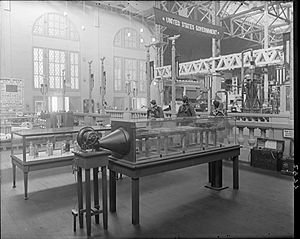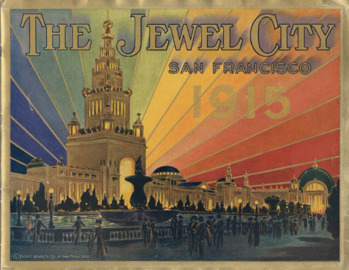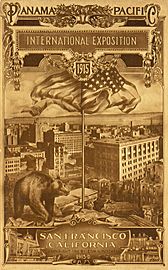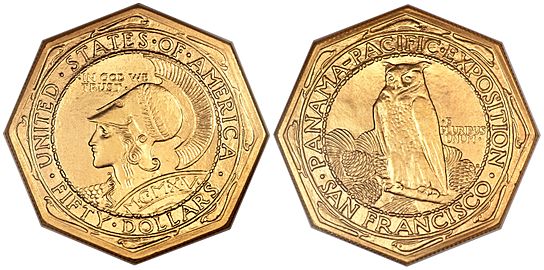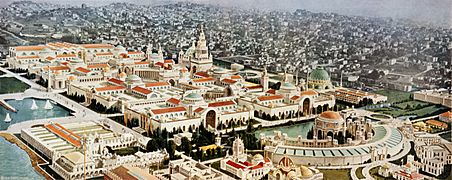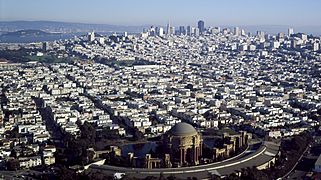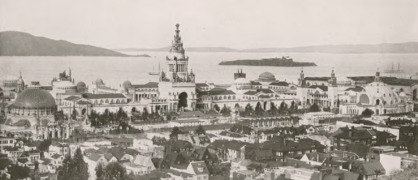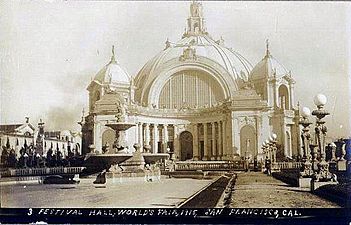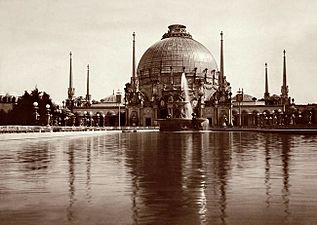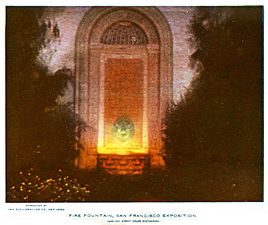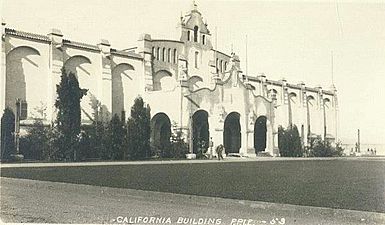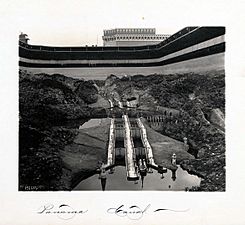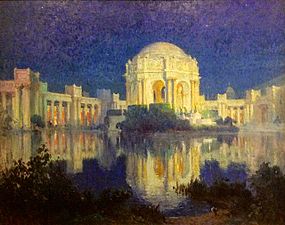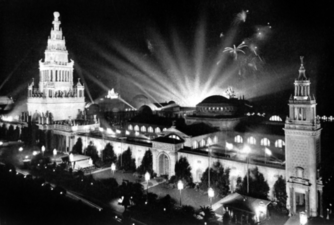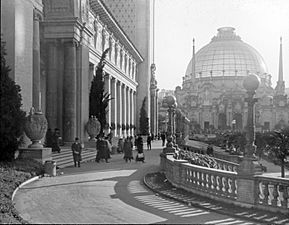Panama–Pacific International Exposition facts for kids
Quick facts for kids 1915 San Francisco |
|
|---|---|
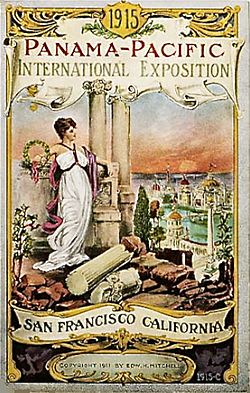
Poster for the exhibition
|
|
| Overview | |
| BIE-class | Universal exposition |
| Category | Historical Expo |
| Name | Panama-Pacific International Exposition |
| Area | 636 acres (257 hectares) |
| Visitors | 18,876,438 |
| Organized by | Charles C. Moore |
| Participant(s) | |
| Countries | 24 |
| Location | |
| Country | United States |
| City | San Francisco |
| Venue | Marina District |
| Coordinates | 37°48′16.8″N 122°26′48″W / 37.804667°N 122.44667°W |
| Timeline | |
| Opening | February 20, 1915 |
| Closure | December 4, 1915 |
| Universal expositions | |
| Previous | Exposition universelle et internationale (1913) in Ghent |
| Next | Independence Centenary International Exposition in Rio de Janeiro |
| Simultaneous | |
| Other | Panama–California Exposition |
The Panama–Pacific International Exposition was a big world's fair held in San Francisco, California, USA. It ran from February 20 to December 4, 1915. The main reason for the fair was to celebrate the completion of the Panama Canal. However, many people in San Francisco also saw it as a chance to show how the city had recovered from the terrible 1906 earthquake.
The fair was built on a large area of about 636 acres (2.6 square kilometers). This land was along the northern shore, between the Presidio and Fort Mason. Today, this area is known as the Marina District.
Contents
What Was on Display at the Fair?
Many interesting things were shown at the Exposition. One famous exhibit was the C. P. Huntington. This was the very first steam locomotive bought by the Southern Pacific Railroad. You can still see this locomotive today at the California State Railroad Museum in Sacramento.
A special telephone line was set up to New York City. This allowed people across the entire continent to hear the sound of the Pacific Ocean. The famous Liberty Bell also traveled by train all the way from Philadelphia to be part of the fair.
The fairgrounds also hosted exciting auto races. The 1915 American Grand Prize and Vanderbilt Cup races took place on February 27 and March 6. The race track was about 3.84 miles (6.18 km) long and went around the Exposition grounds. The Smithsonian Institution also had its own exhibit at the fair.
A special type of noodle called Yumian|zh|魚麵 (which means "fish-noodle" in Chinese) won a silver medal at the Exposition. These noodles are made from flour and fish from the Fushui River in China.
Native American Culture at the Fair
Native American culture was a popular topic at the Exposition. There were several attractions focused on Native American life. The most well-known was a statue by James Earle Fraser called The End of the Trail. This statue showed a Native American man slumped on a horse. At the time, it reflected a common idea that Native American cultures were disappearing.
The fair celebrated American progress, which included the conquest of indigenous people. This idea was seen in artworks like The End of the Trail and The Pioneer. It was also shown in tributes to explorers like Francisco Pizarro and Hernán Cortés. Compared to earlier world's fairs, this Exposition showed Native Americans more as noble figures, but still suggested they were destined to vanish.
Native Americans were also part of the fair as visitors, performers, and workers. They were not just a disappearing civilization.
Women's Roles and Rights
During the Exposition, women had their own group called the Woman's Board. This board allowed women to help organize different parts of the fair. More importantly, it gave them a platform to talk about women's rights and other social issues.
Some people felt the fair focused too much on men. They pointed out that there wasn't a specific building for women. Also, posters for the fair often showed white women as caretakers. Men, however, were shown as strong heroes, like in the poster "13th Labor of Hercules."
At that time, there was a new idea of a "New Woman." This woman was seen as more modern and intelligent. This idea fit well with the fair's themes of progress. To promote the fair, organizers used the "New Woman" image. They wanted to show that San Francisco was a modern and safe place for visitors.
Women were often photographed with farm products from California. These women were usually young, beautiful, and white. They were often featured in newspaper articles and events. This use of women sometimes made it seem like their beauty was more important than their intelligence or abilities.
One important achievement of the Women's Board was putting up statues that honored women, especially mothers. These statues were known as the Pioneer Mother.
Amazing Buildings and Design
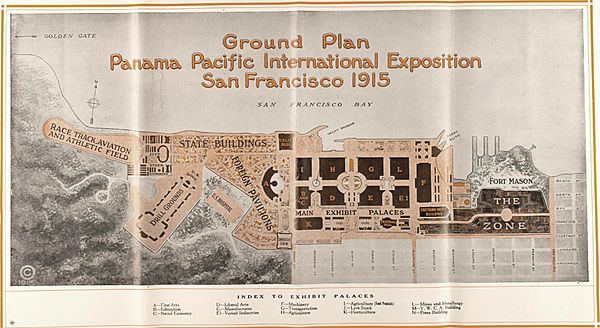
A Fine Arts
B Education
C Social Economy
D Liberal Arts
E Manufacturers
E1 Varied Industries
F Machinery
G Transportation
H Agriculture
I Agriculture (Food Products)
J Live Stock
K Horticulture
L Mines and Metallurgy
The main attraction was the Tower of Jewels. It stood 435 feet (133 meters) tall. The tower was covered with over 100,000 sparkling glass "Novagems." These gems, about 3/4 to 2 inches (1.9 to 5.1 cm) big, glittered in the sun. At night, over 50 powerful searchlights lit them up.
South of the Tower was the Fountain of Energy. It was in the middle of the South Gardens. The Palace of Horticulture was to its west, and Festival Hall to its east. The Tower's arch led to the Court of the Universe. From there, you could go to the Court of the Four Seasons or the Court of Abundance.
These courts were the main exhibit areas. They included palaces for Food Products, Agriculture, Liberal Arts, Education, and Social Economy. Other palaces were for Transportation, Mines and Metallurgy, Varied Industries, and Manufacturers.
The largest building was the Palace of Machinery. It was on the east side of the central court. On the west side was the Palace of Fine Arts. This building is still standing today.
Further west, along the Avenue of the Nations, were buildings from different states and countries. They showed off unique customs and products. The far western end of the fair had exhibits for live animals. On the opposite end, near Fort Mason, was "The Zone." This area had popular rides and food stands.
Building the Fair
Most of the fair's buildings were made from temporary materials. They used "staff," which is a mix of plaster and burlap fiber. Because of this, almost all the buildings were taken down in late 1915. The architect supposedly wanted them to fall apart, believing every great city needed ruins.
The only building still standing on the original fairgrounds is Bernard Maybeck's Palace of Fine Arts. It was used to display paintings and sculptures. During World War II, it became a garage for jeeps. The Palace, including its famous columns and dome, was fully rebuilt in the 1960s. It was also made stronger against earthquakes in 2009. The Exploratorium, a science museum, was in the Palace from 1969 to 2013.
{{wide image|Palace-of-fine-arts-1919.jpg|800px|A panorama of the Palace of Fine Arts around 1919. The current building was rebuilt in the 1960s and made stronger against earthquakes.]]
Other Buildings Still Standing Today
Besides the Palace of Fine Arts, a few other buildings from the Exposition still exist. The Bill Graham Civic Auditorium in Civic Center Plaza is one. The Japanese Tea House was moved by barge to Belmont, California. It has been a private home, a secret bar, and a restaurant.
The small, one-third scale steam locomotives of the Overfair Railroad also survived. They ran at the Exposition. Today, they are kept in working order at the Swanton Pacific Railroad Society. This is located at Cal Poly San Luis Obispo's Swanton Pacific Ranch, north of Santa Cruz.
The Legion of Honor Museum in Lincoln Park is another surviving structure. It was a gift from Alma de Bretteville Spreckels. This museum is a full-size copy of the French Pavilion from the 1915 Exposition. That pavilion was itself a smaller version of a famous building in Paris.
The fair's warehouse was moved to Fort Hunter Liggett in Monterey County. This building, nicknamed the "Tin Barn," has been the base fire department for 30 years. Before that, it was a horse barn, a gym, a store, and a movie theater.
Remembering the Fair
The U.S. Post Office released a set of four postage stamps to remember the Exposition. The designs showed Vasco Núñez de Balboa, the Pedro Miguel Locks of the Panama Canal, the Golden Gate, and the discovery of San Francisco Bay. These stamps were first sold in 1913 to promote the fair.
The United States Congress also allowed the San Francisco Mint to create a series of five special coins. These included a silver half dollar and four gold coins. The gold coins came in $1, $2.50, and two types of $50 coins (one round, one unusual octagonal). These were the first commemorative coins to say "In God We Trust." They were also the first to be made at a branch mint.
100-Year Celebration
In 2015, several groups worked with San Francisco to celebrate the 100th anniversary of the Exposition. On June 20, 2015, a special concert was held at the Palace of Fine Arts. It featured an orchestra, chorus, and band.
A movie called When the World Came to San Francisco was made about the fair. It was part of the city's official celebration. The film first showed at the de Young Fine Arts Museum on October 30, 2015.
Gallery
-
Aerial view of the Panama–Pacific International Exposition, looking southeast. The buildings are colored to show them better. This area is now the Marina District.
-
A modern view of the fairgrounds from 1980, looking east-southeast. The Palace of Fine Arts is easy to spot in the front.
-
View looking north-northeast. The Tower of Jewels is in the center. The domed Palace of Horticulture is on the left. Alcatraz Island can be seen in the distance.
-
Tower of Jewels at night
-
A model of the Panama Canal
-
A modern picture of the Palace of Fine Arts, the only building from the original fairgrounds that still stands today (it was rebuilt)
See also
 In Spanish: Exposición Universal de San Francisco (1915) para niños
In Spanish: Exposición Universal de San Francisco (1915) para niños


